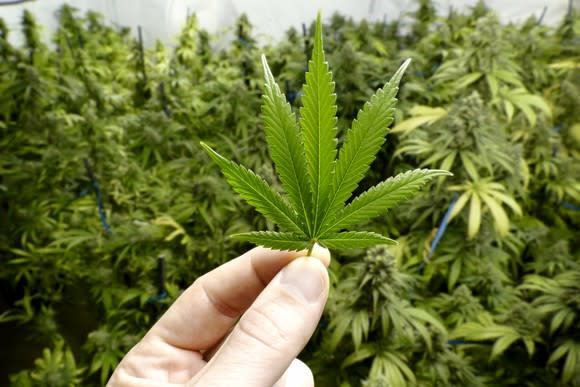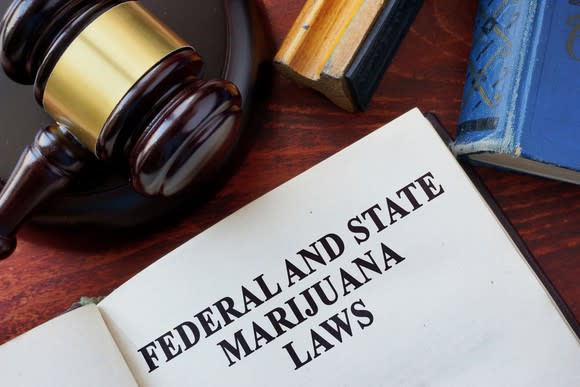Report: Marijuana as a First Drug of Choice Is on the Rise Among Adolescents
In North America, the legal marijuana industry is growing at an exceptionally fast pace. According to cannabis research firm ArcView, sales of legal weed increased by 33% in North America last year, to $9.7 billion, and they're forecast to rise to more than $47 billion annually a decade from now. This growth has been the impetus behind rapidly rising marijuana stock prices.
But within the U.S., despite robust legal-weed sales growth and the state-level legalization of pot in some capacity in 29 states, cannabis remains stuck in neutral.

Image source: Getty Images.
At the federal level, marijuana is classified as a Schedule I drug. This means it's entirely illegal (putting it on par with heroin and LSD), is considered to be prone to abuse, and has no recognized medical benefits. It also means that U.S.-based weed businesses have little or no access to traditional banking services and aren't able to take normal corporate income-tax deductions pursuant to Section 280E of the U.S. tax code. In short, this Schedule I classification makes life incredibly difficult to pot businesses and medical cannabis patients alike in the U.S.
Why doesn't Congress reschedule or deschedule marijuana, you ask? Even with the public overwhelmingly in support of legalizing the drug, lawmakers have concerns about how legalization could impact adolescent access to cannabis, as well as laws pertaining to driving while under the influence.
Cannabis use as a first drug of choice appears to be increasing among adolescents
A little more than a week ago, a new research study published in the journal Prevention Science offered some insight into adolescent cannabis use around the country over a 10-year period. The results yielded some interesting findings, to say the least.
Researchers from the National Institute of Child Health and Human Development, using data from the U.S. National Survey on Drug Use and Health between 2004 and 2014, examined cannabis-, tobacco-, and alcohol-use data on more than 275,500 adolescents aged 12 to 21 years old. In particular, researchers aimed to see if there were any patterns of an increase or decrease in use of these substances among adolescents, as well as ascertain to what extent cannabis, alcohol, and tobacco were being used as a first substance of choice among adolescents (defined as "initiation of use" in the study).

Image source: Getty Images.
The results showed that, in 2004, 4.8% of adolescents admitted to using cannabis before tobacco or alcohol. However, by 2014, this figure had risen to 8%. Meanwhile, adolescents who tried tobacco first declined from 21.4% in 2004 to just 8.9% as of 2014, and the number of adolescents who'd abstained from using any of these substances increased from 35.5% to 46.3% over 10 years. The percentage of adolescents using alcohol first remained relatively constant, with alcohol still the most commonly initiated drug among 12 to 21 year olds.
Why the increased use of cannabis first among adolescents when compared to other substances? The discussion section of the report suggests that the increase in cannabis use may be concurrent with the decline in cigarette smoking. In other words, adolescents are making a conscious trade away from tobacco products and toward marijuana, perhaps as a result of the many published risks associated with smoking. Researchers also offered the theory that the increase in abstinence rates over this decade-long period may be somehow skewing the results to show an increase in cannabis use among adolescents.
It also is worth noting, as is common with these studies, that there are numerous limitations with the data researchers are working with. In particular, there's no way to concretely state that cannabis use among adolescents is on the rise and/or why this is happening. It does, however, merit more research and additional studies.
A double-edged sword for the U.S. marijuana industry
On the surface, this is worrisome data to lawmakers on Capitol Hill. Again, taking into account the context of the study and the fact that nothing can be demonstrated beyond mere correlation at this point, this data still feeds the fear of lawmakers that rescheduling or decriminalizing weed in the U.S. could allow adolescents easier access to pot.

Image source: Getty Images.
What's more, a handful of previously published studies have offered possible evidence of long-term memory and cognitive development concerns associated with frequent marijuana use by adolescents with still-developing brains. In essence, this study is a talking point that encourages on-the-fence lawmakers and opponents of marijuana to keep the drug classified as a Schedule I substance.
However, this data also reinforces the notion that the marijuana industry's future looks promising, thanks to young adults. An April 2018 survey from the independent Quinnipiac University found that 63% of all adults surveyed favored legalizing cannabis. However, of those between the ages of 18 and 34, 82% supported legalization compared to just 16% who were opposed.
Young adults consistently have a more favorable view of marijuana relative to other age groups and more strongly support states' rights than these other groups. This tells me, as an investor, that younger adults should really be the target audience of the U.S. cannabis industry.
Ultimately, one study isn't going to decide whether cannabis does or doesn't represent a threat to our nation's youth. But it does shed light on possible use trends among adolescents. For the cannabis industry, this is something of a double-edged sword.
More From The Motley Fool
The Motley Fool has a disclosure policy.

